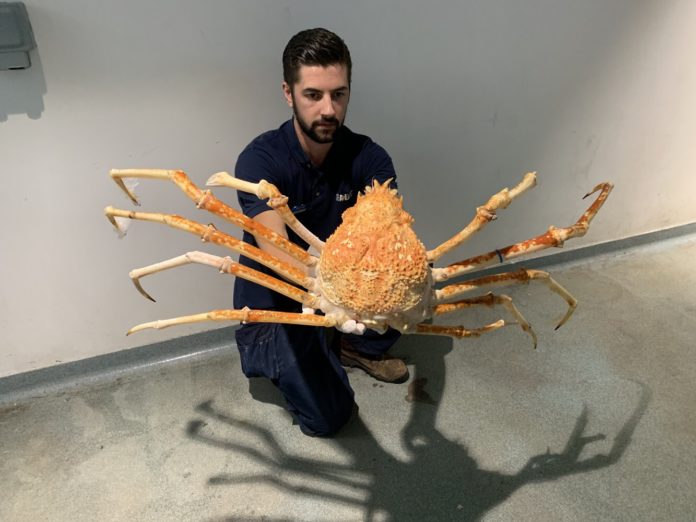A Japanese Spider Crab, the largest species of crab in the world, has been caught on camera by aquarists at Sea Life Manchester, moulting his entire shell.
In a first for the Barton Square attraction, the incredible footage shows the other-worldly creature climbing out of its exoskeleton to reveal a brand new shell, and a body that had almost doubled in size, with a claw-to-claw span of 6ft. With the crabs usually found on the bottom of the Pacific Ocean in depths of up to 600m, visitors were treated to a phenomenon that most humans would not experience in a lifetime.
Luke Benyon, Aquarist at the popular family attraction, worked tirelessly throughout the night to monitor the process, which took a mammoth 18 hours from start to finish, ensuring that everything went swimmingly for the creature.
Brendan Malone, Curator at Sea Life Manchester, comments: “Just over a year ago, the Japanese Spider Crabs arrived at their new, purpose-built forever home here at Sea Life Manchester, after two years of rigorous planning. Ever since, we’ve been looking out for any signs of moulting.
“To be able to witness this fascinating process with our very own eyes has been incredible. It’s fantastic that we’re able to share the footage with our visitors and continue to educate adults and children alike on the weird and wonderful magic of the deep!”
Benyon added: “It is a privilege to have to have the opportunity to watch such a remarkable process in person. It is certainly something I won’t be forgetting in a hurry.”
A natural process, moulting occurs because crabs, and other crustaceans, have a hard outer shell (the exoskeleton) that does not grow, to protect them from predators. As they grow, this can become too tight. A new shell will begin to form under the existing exoskeleton, and the moult occurs when this shell is fully formed.
After moulting, the new shell will be soft for a period of time, leaving the crab susceptible to attack from other creatures. Ensuring the very best care for the extraordinary crustacean, aquarists have placed a specially designed Perspex wall inside the 90,000 litre tank. This will protect the crab’s new shell as it hardens, a process which the Animal Care Team and Sea Life vet estimate will take around six weeks.
The dedicated team will also monitor the crab’s ingestion of calcium and other essential elements, absorbed from the old exoskeleton, which was left in-situ for 24 hours following the moult.
Crushed vitamins will also be given to the crab to contribute to a healthy, hardened shell, disguised in his normal diet which includes squid and mackerel. It is estimated that it could be a decade or more before the crab moults again.
Visitors to the attraction’s ‘Lair of The Giant Crab’ will be able to see the alien-like crustacean rocking his brand new shell, with aquarists on hand to delve deeper into the fascinating process.







